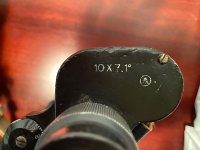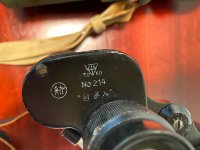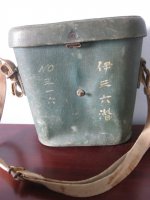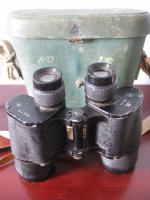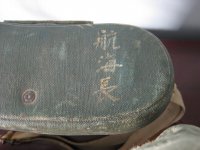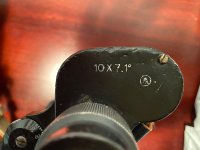-
Welcome to BirdForum, the internet's largest birding community with thousands of members from all over the world. The forums are dedicated to wild birds, birding, binoculars and equipment and all that goes with it.
Please register for an account to take part in the discussions in the forum, post your pictures in the gallery and more.
You are using an out of date browser. It may not display this or other websites correctly.
You should upgrade or use an alternative browser.
You should upgrade or use an alternative browser.
Kanji translation request on 10x50 wide field (1 Viewer)
- Thread starter Foss
- Start date
More options
Who Replied?Steve C
Well-known member
The right side tells you they are 10x with an angular field of view of 7.1*.
Other than it is a model 214, You need to find a Japanese speaker for the left side. I would also assume it originated in Tokoyo.
Look on the objective end of the hinges and see it there are JB and JE numbers. These numbers will identify the maker of the body and the maker of the internals. The J may be tilted inward and not be readily identifiable as a J.
It is likely from the 1950-60's time frame.
Other than it is a model 214, You need to find a Japanese speaker for the left side. I would also assume it originated in Tokoyo.
Look on the objective end of the hinges and see it there are JB and JE numbers. These numbers will identify the maker of the body and the maker of the internals. The J may be tilted inward and not be readily identifiable as a J.
It is likely from the 1950-60's time frame.
Last edited:
If it is Tokyo Optical company, then this was I think connected to Topcon.
The Topcon cameras were considered equal to or better than Nikon in quality.
The U.S Navy? may have chosen the Super DM in preference to the Nikon F?
However, Topcon chose the Exakta bayonet mount, which is very small diameter and meant that the lenses are compromised.
My Topcon 300mm f/2.8 predates Canon 300mm f/2.8s by about ten years.The Topcon is very good, but very long and very heavy. I have it with a Minolta to Exakta converter. However, the Topcon is not exactly Exakta size, so the lens mount is very tight indeed.
So Topcon can be very high quality, but maybe were not so with early binoculars.
I would measure the field and magnification of the binocular. I cannot see the eyepieces, but if narrow angle there may be a slight mistake here.
Are the optics coated?
Regards,
B.
The Topcon cameras were considered equal to or better than Nikon in quality.
The U.S Navy? may have chosen the Super DM in preference to the Nikon F?
However, Topcon chose the Exakta bayonet mount, which is very small diameter and meant that the lenses are compromised.
My Topcon 300mm f/2.8 predates Canon 300mm f/2.8s by about ten years.The Topcon is very good, but very long and very heavy. I have it with a Minolta to Exakta converter. However, the Topcon is not exactly Exakta size, so the lens mount is very tight indeed.
So Topcon can be very high quality, but maybe were not so with early binoculars.
I would measure the field and magnification of the binocular. I cannot see the eyepieces, but if narrow angle there may be a slight mistake here.
Are the optics coated?
Regards,
B.
Last edited:
If it is Tokyo Optical company, then this was I think connected to Topcon.
Regards,
B.
The name looks more like Toko with a symbol between the first 'o' and the 'k'.
Lee
Foss
Well-known member

Hey Troub. Tokyo/Topcon has been confirmed via an old Peter Abrahams file.
Hey Binastro,
Uncoated optics and a magnificent wide view: they're 10x 7.1° for sure. I'll post more photos...wasn't sure this thread was suitable here. BTW: prism cover screws match, it was the camera angle.
From CN forum what I'm learning so far:
- The marking in quotes beneath No. 214 could mean Scale in Lens or Greater Japanese Empire
- The marking on the left prism plate stands for Naval Aviation
The circular marking on the right prism plate has not yet been identified
Hey Binastro,
Uncoated optics and a magnificent wide view: they're 10x 7.1° for sure. I'll post more photos...wasn't sure this thread was suitable here. BTW: prism cover screws match, it was the camera angle.
From CN forum what I'm learning so far:
- The marking in quotes beneath No. 214 could mean Scale in Lens or Greater Japanese Empire
- The marking on the left prism plate stands for Naval Aviation
The circular marking on the right prism plate has not yet been identified
Attachments
Last edited:
jan van daalen
Well-known member
I am sure any Japanese ambassy can take care of this.
Jan
Jan
Hey Troub. Tokyo/Topcon has been confirmed via an old Peter Abrahams file.
I am sure it has Fossy, but I was saying the marks on the bino look like Toko and not Tokyo.
Lee
Hey Troub. Tokyo/Topcon has been confirmed via an old Peter Abrahams file.
Hey Binastro,
Uncoated optics and a magnificent wide view: they're 10x 7.1° for sure. I'll post more photos...wasn't sure this thread was suitable here. BTW: prism cover screws match, it was the camera angle.
From CN forum what I'm learning so far:
- The marking in quotes beneath No. 214 could mean Scale in Lens or Greater Japanese Empire
- The marking on the left prism plate stands for Naval Aviation
The circular marking on the right prism plate has not yet been identified
Foss,
Thanks for sharing this fantastic battlefield relic. A few WAGs and a question.
The wide FOV for a 10 may be explained by the fact the Japanese geared up for war before the British developed radar. Because the Japanese also decided to emphasize fighting at night on land sea and air, and because they had a highly developed optics industry, superior optics (along with extensive training) were the only/obvious option at the time. In fact, I believe through @ mid 1943, Japanese optics often out performed American radar in night surface actions.
Looking at the photos of the case and writing, I wonder whether any expert could tell whether your particular bin was issued to a land based or carrier based Naval air unit? Something about the case says "land based".
Mike
Foss
Well-known member

New information gleaned from a parallel post on a popular astronomy binocular forum. They were designated as Naval Aviation binoculars and were property of the navigation officer aboard IJN Submarine I-36. There's a wealth of information on the sub at http://www.combinedfleet.com/I-36.htm.
Interesting read--there's a lot of time to do so at the moment, sadly.
Thanks all! Foss
(Troub, logo looks like TOKO to me too. I've heard of silent letters, but invisible?)
Interesting read--there's a lot of time to do so at the moment, sadly.
Thanks all! Foss
(Troub, logo looks like TOKO to me too. I've heard of silent letters, but invisible?)
Last edited:
One mystery remains: the meaning of the mark in the circle.
If anyone can get access to a Kenkyusha Japanese dictionary it might be possible to work out what this means.
Lee
[QUOTE
(Troub, logo looks like TOKO to me too. I've heard of silent letters, but invisible?)[/QUOTE]
Actually it is not printed as a four-letter word because it is split in the middle by the graphic so it is actually TO KO.
Names in English often do not follow grammatical rules or usage so if TO KO is a name it may not follow grammatical rules either so it might not be amenable to a direct simple translation.
However, here goes: TO usually means 'and' in Japanese and so appears between two nouns. This is not a helpful start. KO can mean child, or at least someone younger than the speaker, and by extension can mean a kind of off-shoot which might suggest a subsidiary company (I'm guessing here) BUT one source mentions that KO can be used as a collective noun for military units.
So it is possible TO KO isn't a logo or company name but indicates allocation of the bino to some section of the military.
Lee
(Troub, logo looks like TOKO to me too. I've heard of silent letters, but invisible?)[/QUOTE]
Actually it is not printed as a four-letter word because it is split in the middle by the graphic so it is actually TO KO.
Names in English often do not follow grammatical rules or usage so if TO KO is a name it may not follow grammatical rules either so it might not be amenable to a direct simple translation.
However, here goes: TO usually means 'and' in Japanese and so appears between two nouns. This is not a helpful start. KO can mean child, or at least someone younger than the speaker, and by extension can mean a kind of off-shoot which might suggest a subsidiary company (I'm guessing here) BUT one source mentions that KO can be used as a collective noun for military units.
So it is possible TO KO isn't a logo or company name but indicates allocation of the bino to some section of the military.
Lee
Last edited:
John A Roberts
Well-known member

For what it’s worth . . .
Googling the following: “To Ko” Japanese binocular marking
produces several entries with images that indicate that it stands for the manufacturer Tokyo Kogaku Kikai aka Tokyo Optical
John
Googling the following: “To Ko” Japanese binocular marking
produces several entries with images that indicate that it stands for the manufacturer Tokyo Kogaku Kikai aka Tokyo Optical
John
Hi Foss,
It might be worth it to share the story on http://www.j-aircraft.org forum too, there are some very knowledgable people (including native speakers) on that board (who have access to non-published archive material and often are able to add fascinating details to many obscure aspects of WW2 history).
Despite the name of the forum, it's as much about ships as it's about aircraft, so an artifact from the IJN submarine should be perfectly in focus over there.
Regards,
Henning
New information gleaned from a parallel post on a popular astronomy binocular forum. They were designated as Naval Aviation binoculars and were property of the navigation officer aboard IJN Submarine I-36.
It might be worth it to share the story on http://www.j-aircraft.org forum too, there are some very knowledgable people (including native speakers) on that board (who have access to non-published archive material and often are able to add fascinating details to many obscure aspects of WW2 history).
Despite the name of the forum, it's as much about ships as it's about aircraft, so an artifact from the IJN submarine should be perfectly in focus over there.
Regards,
Henning
Foss
Well-known member

Thank you one and all. With help from around the planet, I humbly submit this for review:
Case:
Top: Head of Navigation Department
Front right: I-36 (B-1 class submarine that carried float plane)
Front left: No. 316
Binocular left prism cover:
Logo: Tokyo Optical Co. Ltd (modern Topcon)
In quotes: Scale in lens
Within circle: Naval Aviation
Binocular right prism cover:
Within circle: Standard
Case:
Top: Head of Navigation Department
Front right: I-36 (B-1 class submarine that carried float plane)
Front left: No. 316
Binocular left prism cover:
Logo: Tokyo Optical Co. Ltd (modern Topcon)
In quotes: Scale in lens
Within circle: Naval Aviation
Binocular right prism cover:
Within circle: Standard
The aircraft modeller for the RAF museum left 700 completed high quality model aircraft.
His wife donated them to a local charity shop over the road from her house.
The staff and customers damaged 400 of these delicate plastic model aircraft.
I bought the remaining 300 making many journeys carrying them in cardboard boxes.
I identified all but one.
I think that it is the Watanabe E9W Japanese submarine-borne reconnaissance seaplane in orange colour.
Designed by Watanabe ironworks.
It is a biplane with radial engine.
B.
His wife donated them to a local charity shop over the road from her house.
The staff and customers damaged 400 of these delicate plastic model aircraft.
I bought the remaining 300 making many journeys carrying them in cardboard boxes.
I identified all but one.
I think that it is the Watanabe E9W Japanese submarine-borne reconnaissance seaplane in orange colour.
Designed by Watanabe ironworks.
It is a biplane with radial engine.
B.
The registration number on the model Japanese seaplane is something like the Greek letter Pi-836.
In very large letters on the top wing and small letters near the rudder. In black.
Plus large red circles.
I would think that the binocular was used both in the seaplane and from the submarine.
Probably why it says Naval Aviation.
I haven't found a photo of this particular aircraft.
180mm aperture binoculars were used on Japanese capital ships.
They also made, I think, a 250mm refracting binocular.
I think that the U.S. copied the Japanese 150mm binoculars.
B.
In very large letters on the top wing and small letters near the rudder. In black.
Plus large red circles.
I would think that the binocular was used both in the seaplane and from the submarine.
Probably why it says Naval Aviation.
I haven't found a photo of this particular aircraft.
180mm aperture binoculars were used on Japanese capital ships.
They also made, I think, a 250mm refracting binocular.
I think that the U.S. copied the Japanese 150mm binoculars.
B.
Similar threads
- Replies
- 42
- Views
- 3K
Users who are viewing this thread
Total: 2 (members: 0, guests: 2)




